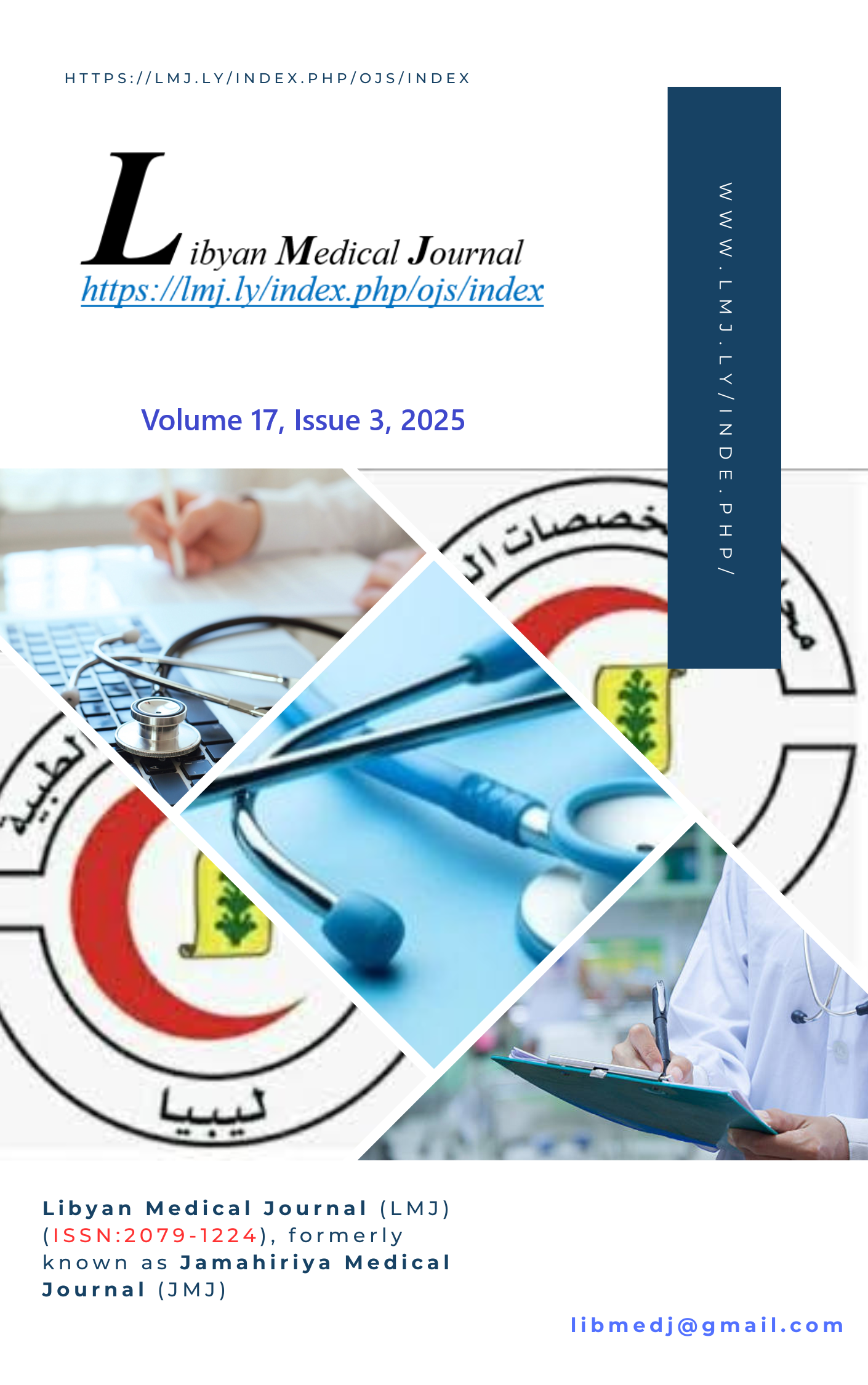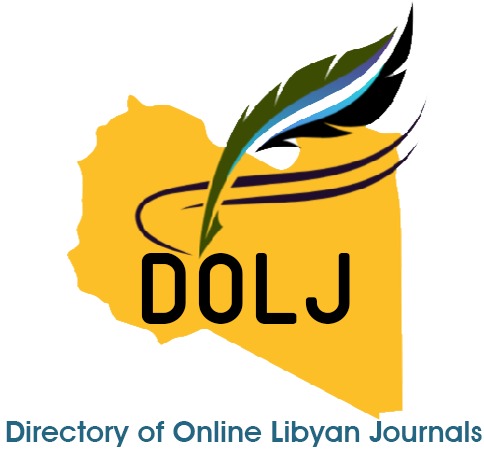Physiotherapy Interventions for Breast Cancer Survivors: Practice Patterns and Perceived Barriers in Tripoli, Libya
DOI:
https://doi.org/10.69667/lmj.2517313Keywords:
Post-Mastectomy Care, Referral Patterns, Therapeutic Interventions, Barriers to Physiotherapy, and Manual Lymphatic Drainage.Abstract
Post-operative physiotherapy is a cornerstone in enhancing the quality of life and functional recovery of breast cancer survivors. Despite its recognized importance, there is a paucity of data regarding physiotherapy practices, referral patterns, and clinical challenges in the management of post-operative breast cancer patients in Libya. This study aimed to investigate the clinical practices, referral trends, and therapeutic interventions employed by physiotherapists in Tripoli, Libya, in managing post-operative breast cancer patients. Additionally, it sought to identify key barriers hindering the delivery of optimal physiotherapy care in this population. A descriptive cross-sectional study was conducted from June 4 to July 4, 2022, involving 35 physiotherapists working in major public hospitals and private rehabilitation centers across Tripoli. Participants were selected based on their prior experience with breast cancer patients. Data were collected using a structured, pre-validated questionnaire adapted from international sources, and data were analyzed using SPSS version 26. Most of the physiotherapists surveyed were female (74.3%) and between the ages of 25 and 35. While 60% had less than five years of experience managing breast cancer cases, nearly two-thirds (62.9%) reported not having received any formal training in oncology rehabilitation. Most participants treated fewer than 20 breast cancer patients per year, and 60% indicated that physiotherapy referrals were typically made only after surgery. The most reported barriers to effective care included patients’ psychological distress (77.1%), followed by low adherence to treatment and insufficient professional training. Regarding treatment methods, passive mobilization, postural correction, and manual therapy were frequently used during the first two weeks post-surgery. Strengthening and range-of-motion exercises were usually introduced later in the subacute recovery phase, while electrotherapy was the least commonly applied. A statistically significant difference (p < 0.001) in the timing and frequency of interventions points to a lack of standardized physiotherapy practices across facilities. The findings underscore a pressing need for structured training programs, the development of standardized physiotherapy protocols, and the integration of physiotherapy services into the early stages of breast cancer care in Libya. Improving education for physiotherapists and refining referral mechanisms may substantially enhance rehabilitation outcomes and overall quality of life for breast cancer survivors. Furthermore, future research is recommended to assess the long-term effects of physiotherapy on physical and psychological outcomes in post-operative breast cancer patients. Larger, multi-center studies are needed to develop evidence-based guidelines suited to the Libyan context
References
Sung H, Ferlay J, Siegel RL, Laversanne M, Soerjomataram I, Jemal A, Bray F. Global cancer statistics 2020: GLOBOCAN estimates of incidence and mortality worldwide for 36 cancers in 185 countries. CA Cancer J Clin. 2021;71(3):209–49.
Knaul FM, et al. Closing the Cancer Divide: An Equity Imperative. Cambridge (MA): Harvard Global Equity Initiative; 2012.
Gupta A, Shridhar K, Dhillon PK. A review of breast cancer awareness among women in India: Most still unaware. Asia Pac J Clin Oncol. 2015;11(1):1–9.
Ben Abdallah M, et al. Cancer registration and surveillance in North Africa: Status, challenges, and future directions. Lancet Oncol. 2017;18(3):e229–36.
Atia A, Essam N, Fathi M, Abdullah N, Ahmed R. Cancer prevalence in Libya: A systematic literature review. Libyan Int J Oncol. 2025;4(1):1–6.
Andersen KG, Kehlet H. Persistent pain after breast cancer treatment: A critical review of risk factors and strategies for prevention. J Pain. 2011;12(7):725–46.
Tait RC, Zoberi K, Ferguson M, Levenhagen K. Persistent post-mastectomy pain: Risk factors and current approaches to treatment. J Pain Res. 2018;11:2611–8.
Vilholm OJ, Cold S, Rasmussen L, Sindrup SH. The postmastectomy pain syndrome: An epidemiological study on the prevalence of chronic pain after surgery for breast cancer. Br J Cancer. 2008;99(4):604–10.
Kannan P, Lam HY, Ma TK, Lo CN, Mui TY, Tang WY. Efficacy of physical therapy interventions on quality of life and upper quadrant pain severity in women with post‐mastectomy pain syndrome: A systematic review and meta‐analysis. Qual Life Res. 2022;31:951–73.
Lacomba MT, Del Moral OM, Zazo JLC, Gerwin RD, Goñi ÁZ. Incidence of myofascial pain syndrome in breast cancer surgery: A prospective study. Clin J Pain. 2010;26(4):320–5.
Kuehn T, Klauss W, Darsow M, Regele S, Flock F, Maiterth C, et al. Long-term morbidity following axillary dissection in breast cancer patients: Clinical assessment, significance for life quality and the impact of demographic, oncologic and therapeutic factors. Breast Cancer Res Treat. 2000;64(3):275–86.
Caffo O, Amichetti M, Ferro A, Lucenti A, Valduga F, Galligioni E. Pain and quality of life after surgery for breast cancer. Breast Cancer Res Treat. 2003;80(1):39–48.
Vilholm OJ, Cold S, Rasmussen L, Sindrup SH. The postmastectomy pain syndrome: An epidemiological study on the prevalence of chronic pain after surgery for breast cancer. Br J Cancer. 2008;99(4):604–10.
De Groef A, Van Kampen M, Dieltjens E, Devoogdt N, Christiaens MR, Neven P. Effectiveness of postoperative physical therapy for upper-limb impairments after breast cancer treatment: A systematic review. Arch Phys Med Rehabil. 2015;96(6):1140–53.
Kisner CN, Colby LA. Management of vascular disorders of the extremities: Guidelines for management after breast cancer surgery. In: Therapeutic Exercise: Foundations and Techniques. 5th ed. Philadelphia (PA): F.A. Davis Company; 2007. p.840–2.
Breivik H, Brochgrevink PC, Allen SM, Rosseland LA, Romundstad L, Hals EK, et al. Assessment of pain. Br J Anaesth. 2008;101(1):17–24.
Mazuquin BF, Swain ID, Lewis J, Watson T. Current physical therapy care of patients undergoing breast reconstruction for breast cancer: A survey of practice in the United Kingdom and Brazil. Support Care Cancer. 2021;29(9):5127–37.
Abdulqadir AH, Krayem KA, Alharam AH, Alekish AM, Mami AA. Physiotherapy and mastectomy: The physiotherapists’ professional role in improving life for mastectomy patients in Al-Zawia, Libya. Presented at: The First Scientific Conference for Medical and Health Sciences, University of Zawia; 2024. p.167–76.
Klein I, Kalichman L, Chen N, Susmallian S. A pilot study evaluating the effect of early physical therapy on pain and disabilities after breast cancer surgery: Prospective randomized control trial. Breast. 2021 Oct;59:286–93.
National Institute for Health and Care Excellence (NICE). Early and locally advanced breast cancer: Diagnosis and management (NG101). London: NICE; 2018. Available from: https://www.nice.org.uk/guidance/ng101
American Cancer Society (ACS). Breast Cancer Survivorship: Recovery and Exercise Guidelines. Atlanta (GA): ACS; 2020. Available from: https://www.cancer.org
Cardoso F, Kyriakides S, Ohno S, et al. Early breast cancer: ESMO Clinical Practice Guidelines for diagnosis, treatment and follow-up. Ann Oncol. 2019;30(8):1194–220.
Rees S, Mazuquin B, Richmond H, et al. Role of physiotherapy in supporting recovery from breast cancer treatment: A qualitative study embedded within the UK PROSPER trial. BMJ Open. 2021;11:e040116.
De Groef A, Van Kampen M, Dieltjens E, et al. Effect of exercise on upper limb dysfunctions and quality of life in breast cancer patients: A systematic review and meta-analysis. Arch Phys Med Rehabil. 2015;96(6):1140–53.
Campbell KL, Zadravec K, Bland KA, Chesley E, Wolf F, Pritchard-Wiart L. Exercise guidelines for cancer survivors: Consensus statement from international multidisciplinary roundtable. Med Sci Sports Exerc. 2020;51(11):2375–90.
Potter S, Brigic A, Whiting PF, et al. Adverse events after breast surgery: A systematic review and meta-analysis. Br J Surg. 2013;100(8):1056–72.
McNeely ML, Campbell KL, Rowe BH, Klassen TP, Mackey JR, Courneya KS. Effects of exercise on breast cancer patients and survivors: A systematic review and meta-analysis. CMAJ. 2010;175(1):34–41.
Zimmermann A, Wozniewski M, Szklarska A, et al. Efficacy of manual lymphatic drainage in preventing secondary lymphedema after breast cancer surgery. Lympholog. 2021;45:103–12.
Liang M, Chen Q, Peng K, Deng L, He L, Hou Y, et al. Manual lymphatic drainage for lymphedema in patients after breast cancer surgery: A systematic review and meta-analysis of randomized controlled trials. Medicine (Baltimore). 2020;99(49):e23192.
Hemmati M, RojhaniShirazi Z, Zakeri ZS, Akrami M, Salehi Dehno N. The effect of the combined use of complex decongestive therapy with electrotherapy modalities for the treatment of breast cancer–related lymphedema: A randomized clinical trial. BMC Musculoskelet Disord. 2022;23:837.
Laakso EL, Young C. Electrophysical agents for symptom control in cancer care: What is the evidence? Phys Ther Rev. 2010;15(4):334–44











